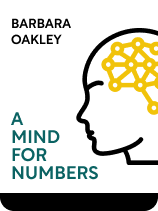

This article is an excerpt from the Shortform book guide to "A Mind for Numbers" by Barbara Oakley. Shortform has the world's best summaries and analyses of books you should be reading.
Like this article? Sign up for a free trial here .
How are your learning habits? Is procrastination one of them?
You can make the most of your study time when you take control of your habits. A Mind for Numbers includes four strategies for changing your learning habits—and three ways to overcome the habit of procrastination.
Keep reading to discover how to establish effective learning habits.
Take Control of Your Learning Habits
Oakley discusses how you can take control of your study habits to make the most of your study time.
Understand the Habit Chunk
According to Oakley, your study habits (good or bad) will have a strong impact on your ability to learn math and science. She explains that habits develop via the same chunking process that condenses information in your brain and facilitates storage in your memory. A habit chunk consists of four pieces of information:
- The Cue: Oakley identifies this as the stimulus that your brain responds to by performing the habitual action. She notes that cues can be linked to people, places, time, feelings, or events.
- The Routine: This is the action or sequence of actions that you perform when the habit is triggered by the cue.
- The Reward: Oakley asserts that you have to derive some kind of benefit from executing the routine for a learning habit to develop. Your brain executes the routine in response to the cue because it expects the reward. She also points out that only immediate consequences of the routine are stored as part of the habit chunk. This is why bad habits are possible: The reward is immediate but transient and the long-term consequences are negative, but the long-term consequences are not processed as part of the habit chunk, and thus do not automatically cancel out the reward.
- The Belief: According to Oakley, your learning habits are grounded in your perception of reality and of your own identity.
For example, suppose you make a habit of reading your text messages immediately:
- The cue is the ringtone your phone plays when you get a text.
- The routine might consist of retrieving your phone from your pocket and accessing the text-messaging app.
- The reward is the pleasure that you derive from reading text messages.
- The underlying belief could vary: Maybe you believe responding promptly to communications is an important part of being respectful toward others, or maybe you identify as a social person and believe in staying connected with others through text.
| Comparing Habit Models Charles Duhigg, author of The Power of Habit, and James Clear, author of Atomic Habits, offer descriptions of the make-up of a habit that are similar to Oakley’s model (although both omit the “belief” element of Oakley’s model). However, BJ Fogg, author of Tiny Habits, provides an alternative model. According to Fogg’s behavioral model, you perform an action or behavior when a prompt alerts you to the opportunity to do so, and the combination of your ability to complete that action and motivation to do so is above a certain threshold. Fogg’s model applies both to habits and to non-habitual actions. Fogg conceives habits as self-perpetuating. The more often you do something, the better you get at doing it, so your ability to do it increases. Further, the habit reward provides motivation to keep doing it. This combination of increasing ability and increasing motivation makes a behavior more likely to exceed the threshold the next time you receive the prompt—thus making you more likely to engage in the habit again. |
Strategies for Changing Learning Habits
As Oakley explains, you can modify your habits by making changes to any part of the habit chunk:
1) Oakley suggests that you can prevent bad habits from triggering by isolating yourself from their cues. For instance, if hearing a certain song while driving triggers you to habitually speed, remove this song from your driving playlist.
(Shortform note: Clear corroborates this suggestion of Oakley’s. He proposes four “laws” of forming new habits, each with an inverse form for breaking bad habits. His first law is to make cues obvious, and inversely, to prevent bad habits from triggering by making their cues invisible.)
2) Overwrite the habit routine by changing how you react to the cue. Oakley notes that this strategy requires a deliberate plan and an exertion of willpower, but that it plays a key role in optimizing your learning habits.
(Shortform note: Fogg identifies this same strategy of changing the behavior associated with a certain prompt. However, instead of highlighting the need for willpower, he advises designing the replacement behavior to take as little willpower as possible. To do this, he advises you to make the replacement behavior easier and more desirable (higher ability and motivation) than the old one.)
3) According to Oakley, sometimes you can modify the habit by manipulating the reward. If you understand what reward is tied to a certain habit, you may be able to change the reward to either reinforce or dismantle the habit. For instance, creating rewards for sticking to good habits can keep you on the right track.
(Shortform note: In Fogg’s model, rewards primarily influence motivation. He cautions you to avoid basing habit changes too much on motivation, because motivation is often complex and can be fickle. Nevertheless, he presents celebrating small victories as a key strategy for reinforcing changes that you are trying to make to your habits.)
4) Address underlying beliefs fueling the habit. Oakley asserts that to change a habit, you must believe that you can change and that the change will be an improvement.
(Shortform note: Clear observes that it is particularly easy to pick up habits from people you are close to or look up to because these people influence your beliefs. This implies that you can sometimes prompt a change in your habits by changing the company you keep and thus changing your beliefs.)
Overcome Procrastination
You can overcome procrastination by first understanding the procrastination habit (or chunk) and then implementing three strategies.
Understand the Procrastination Chunk
Oakley asserts that habitual procrastination is often your most significant barrier to learning math and science. She explains that procrastination is a special kind of habit, but it has the same basic components as any habit chunk:
- The Cue: According to Oakley, the procrastination cue comes in two parts. The first part is the unpleasant feeling that you get from anticipating an activity that makes you uncomfortable. The second part is the “distraction,” which is any stimulus that you can shift your focus to in order to escape the pain of anticipation.
- The Routine: Oakley explains that the procrastination chunk in your brain generally doesn’t have just one routine, but rather several sub-routines. The type of distraction that completes the cue determines which sub-routine gets triggered. For example, if the distraction is a new email from an online retailer, maybe the sub-routine consists of following the link in the email and mindlessly browsing the retailer’s website.
- The Reward: According to Oakley, the reward that allows a procrastination habit to develop is temporary relief from the pain of anticipation.
- The Belief: Oakley reiterates that one of the keys to changing any habit is believing that you can change. If you’ve been procrastinating habitually for a long time, it might be tempting to believe procrastination is an innate part of who you are, but understanding the makeup of the procrastination habit can help you change this belief.
| Oakley and Eyal: Procrastination vs Distraction Some authors discuss a process similar to Oakley’s “procrastination” using different terms. For instance, Nir Eyal uses the term “distraction” to define any behavior that draws you away from the tasks that you need to focus on to accomplish your goals. He asserts that we are all fundamentally motivated to free ourselves from discomfort, and we get distracted because distractions offer temporary relief from mental discomfort. Furthermore, he states that distractions start with “triggers” and distinguishes between internal and external triggers. He equates internal triggers to the sense of discomfort or dissatisfaction that prompts you to look for an escape. External triggers, then, are environmental stimuli that interrupt your concentration and/or offer an opportunity for escape. Thus, “distraction” as used by Eyal seems to be functionally synonymous with “procrastination” as used by Oakley, and Eyal’s description of the root cause of distraction is compatible with Oakley’s description of the procrastination habit model. As such, we can compare Oakley’s strategies for avoiding procrastination to Eyal’s for additional perspective. |
Strategies for Overcoming Procrastination
In addition to her general strategies for changing habits, Oakley provides strategies specifically for combating procrastination:
1) Plan your time. According to Oakley, just having a plan for how to spend your time can reduce the temptation to procrastinate, and tracking your time can help you identify specific procrastination habits. To this end, she recommends keeping a daily to-do list in a journal planner or on a conspicuous whiteboard.
(Shortform note: Eyal also identifies building the right schedule as one of the key strategies for overcoming distraction. However, he asserts that just making a to-do list of daily tasks is not enough, because it’s too easy to move uncompleted tasks to tomorrow’s list if you slip into distraction. Instead, he prescribes “timeboxing,” where you split up your entire day into blocks (or boxes) of time, all of which are allocated to specific activities. This way, if you find yourself doing anything other than what you planned to be doing at that time of the day or night, you can identify exactly when you were distracted. Eyal recommends scheduling one 20-minute box each week to reflect on the times you got distracted and consider how you could adjust your schedule to avoid such distractions in the future.)
2) Eliminate distractions. Oakley points out that avoiding distractions can prevent your procrastination sub-routines from triggering.
(Shortform note: Eyal likewise identifies “eliminating triggers” as one of the keys to conquering distraction. He presents a list of triggers to manage, including in-person interruptions, incoming email, text, or social media media, and desktop clutter. By letting people know when you are and are not available, disabling notifications for most incoming communications, establishing set time-boxes for responding to communications, and keeping an organized desktop, Eyal says you can greatly reduce distractions.)
3) Ignore distractions. Oakley acknowledges that this requires an exertion of willpower, much like overwriting a habit routine, but she says this is a key strategy for overcoming procrastination habits. She notes that you can use meditation techniques to let distractions pass.
(Shortform note: Author Bhante Gunaratana describes “mindfulness” meditation as a state of mental awareness in which you listen to your thoughts without getting caught up in them. You just observe what’s going on in your mind, without expecting, reacting, pondering, analyzing, or passing judgment on any of it. Medical studies affirm that this meditation technique tends to reduce susceptibility to distraction. Presumably, every time you observe a distraction without responding to it, the association between the distraction and its procrastination sub-routine grows weaker.)

———End of Preview———
Like what you just read? Read the rest of the world's best book summary and analysis of Barbara Oakley's "A Mind for Numbers" at Shortform .
Here's what you'll find in our full A Mind for Numbers summary :
- How to make math and science intuitive
- Strategies for remembering complex concepts more easily
- How to build good study habits and avoid procrastination






